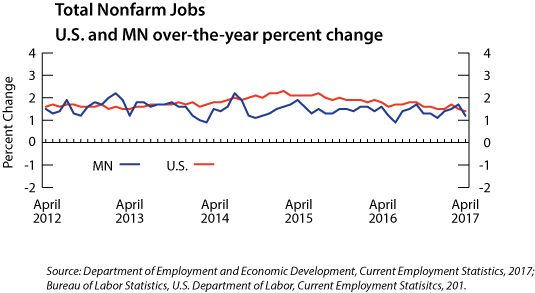by Nick Dobbins
May 2017
Monthly analysis is based on unadjusted employment data.
Employment in the Minneapolis-St. Paul-Bloomington MSA increased by 27,024 (1.4 percent) in April. Significant over-the-month increases are very common in April as warm-weather employment has generally begun to ramp up, but schools have yet to let out for the summer. As would be expected, the two supersectors primarily responsible for driving this growth were Mining, Logging, and Construction (up 6,133 or 8.7 percent) and Leisure and Hospitality (up 5,920 or 3.5 percent), although every supersector save Information (down 23 jobs or 0.1 percent) grew on the month. On an annual basis the metro area added 29,104 jobs (1.5 percent). The net jobs added would represent roughly 84 percent of job growth in the state. However, April’s increase is actually a decline from the 2.1 percent over-the-year growth the area saw in March, although that seems to have more to do with late-starting spring job growth last year than with any irregularities this year. As has been the case for some time, Educational and Health Services added the most jobs on the year, up 12,783 (4 percent). Leisure and Hospitality was the only supersector in the area to have negative growth on the year, off by 3,843 (2.1 percent), with Accommodation and Food Services shedding 5,034 jobs (3.4 percent) and Arts, Entertainment, and Recreation adding 1,191 (3.7 percent).
The Duluth-Superior MSA added 829 jobs (0.6 percent) in April. The most dramatic growth came in Leisure and Hospitality, which added 682 jobs (5.4 percent). Significant growth in the supersector is common this time of year. Trade, Transportation, and Utilities lost 241 jobs (1 percent) on the month, with the entirety of those losses coming in the Retail Trade component (down 262 or 1.7 percent). The other two component sectors saw small growth. Annually Duluth added 298 jobs (0.2 percent). By far the largest gains, in both absolute and proportional terms, came in Mining, Logging, and Construction, which added 881 jobs or 10.9 percent. This was the fourth consecutive month where the supersector had over 10 percent over-the-year growth on the heels of consistent losses through 2016 and late 2015.
Employment in the Rochester MSA was up by 1,243 (1.1 percent) in April. Mining, Logging, and Construction added 633 jobs (18 percent). While growth in the supersector is common this time of year, this was its fastest over-the-month growth since April of 2010. Professional and Business Services also showed strong growth, adding 226 jobs (4.2 percent), its largest over-the-month growth since 2012. Annually Rochester added just 911 jobs (0.8 percent). Although this is up from the 0.6 percent annual growth the MSA showed in March, it remains well below the statewide rate of 1.2 percent growth on the year. Financial Activities grew by 119 jobs (4.6 percent), the biggest proportional change, and Educational and Health Services added 1,117 jobs (2.3 percent), the largest addition of actual jobs in the MSA.
Employment in the St. Cloud MSA was up by 2,299 (2.1 percent) in April, after having been flat in March. The 2.1 percent growth mark was by far the largest posted by any MSA in the state. Mining, Logging, and Construction added 545 jobs (9 percent), Professional and Business Services added 305 (3.6 percent), and Leisure and Hospitality added 684 (8.4 percent). Annually St. Cloud added 1,484 jobs (1.4 percent). The annual growth rate of the MSA outpaced the state’s 1.2 percent growth. Mining, Logging, and Construction added 558 jobs (9.2 percent) on the year, and Educational and Health Services added 1,094 (5 percent).
The Mankato-North Mankato MSA added 503 jobs (0.9 percent) in April. Every published industry group saw gains, with goods producers adding 306 jobs (3.2 percent) and service providers adding 197 (0.4 percent). Government employment was largely flat, adding just six jobs (0.1 percent). Annually Mankato lost 142 jobs (0.2 percent). It joined Grand Forks-East Grand Forks as the only MSAs in the state to lose jobs over the year.
The Fargo-Moorhead MSA added 1,417 jobs (1 percent) in April. Mining, Logging, and Construction added 762 jobs (9.4 percent), and Professional and Business Services added 493 (3.3 percent). Annually the Fargo-Moorhead area added 2,012 jobs (1.4 percent), making it one of only three MSAs to match or exceed the state growth rate. The fastest growth occurred in Educational and Health Services, which added 1,181 jobs (5.2 percent).
The Grand Forks-East Grand Forks MSA added 118 jobs (0.2 percent) in April. This was the smallest monthly gain of any MSA in the state for the month. The uncharacteristic weakness may have been in part from the decline of 137 (4.5 percent) in Mining, Logging, and Construction. Not only was this the only MSA to lose jobs in the supersector, every other MSA grew by at least 2 percent on the month, and the state as a whole saw 10.1 percent more jobs in the supersector. Annually the Grand Forks-East Grand Forks area lost 55 jobs (0.1 percent). It joined Mankato as the only MSAs in the state to lose jobs over the year. Mining, Logging, and Construction was once again a notable culprit, shedding 317 jobs (9.8 percent) on the year.
